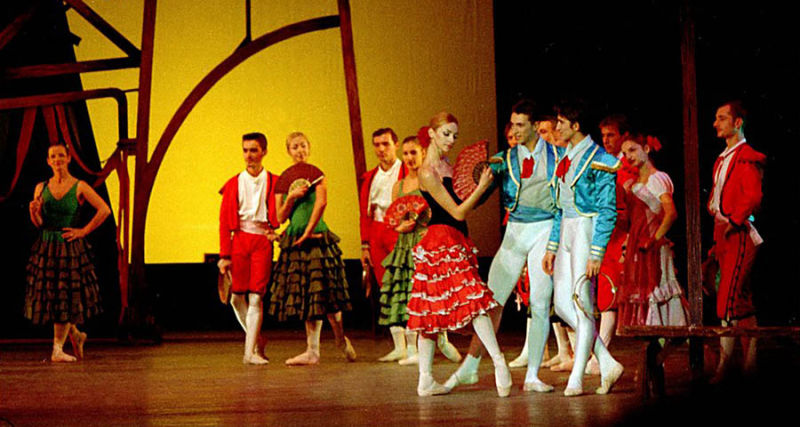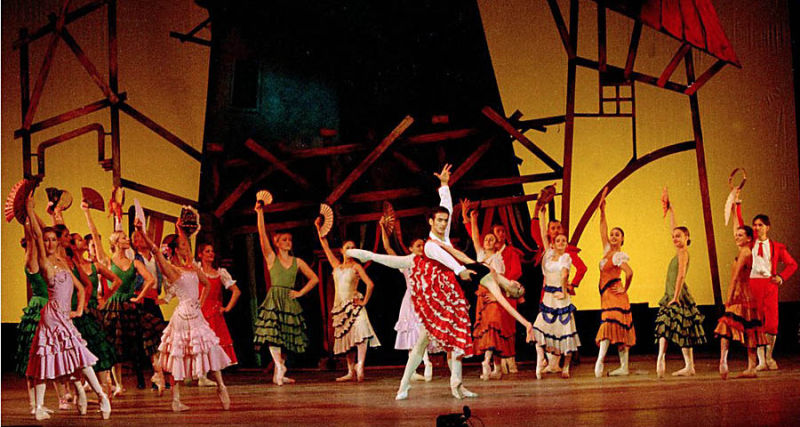










Don Chisciotte, un eccentrico gentiluomo di campagna, si ritiene legittimo successore dei cavalieri erranti medievali, sui quali ha letto moltissimo. Ormai sogna soltanto la nobile dama Ducinea, per la quale combatterà le sue battaglie. I suoi sogni sono interrotti dal suo vicino Sancho Panza, che sta fuggendo dopo aver rubato un pollo.Don Chisciotte lo nomina suo scudiero e insieme a lui parte per avventure cavalleresche di guerra e amore.
Il Don Chisciotte mette in scena l’omonimo romanzo di Cervantes pubblicato all’inizio del Seicento. La prima rappresentazione di questo balletto avvenne a Parigi nel 1801, coreografie di Louis Jacques Milon e le musiche di Lefebre. Questa versione ebbe così tanto successo da rimanere per venti anni nella programmazione dell’Opéra. Nel 1869 fu la scuola del balletto russo a creare la versione che si impose nel panorama della danza. Marius Petipa decise di proporre uno spettacolo innovativo rinunciando al carattere drammatico per far spazio alla commedia, con un personaggio bizzarro come Don Chisciotte. Il balletto va in scena il 14 dicembre 1869 a Mosca, al Teatro Bolshoy, con la coreografia di Marius Petipa sulla musica di Aloisius Ludwig Minkus , che trae ispirazione dal celebre romanzo di Cervantes. In realtà, come spesso accade per i balletti del repertorio accademico, il riferimento alla fonte letteraria costituisce solo un pretesto per narrare la vicenda amorosa di Kitri, figlia dell'oste e da questi promessa in sposa al nobile Gamache e Basilio, un giovane barbiere di cui la ragazza è innamorata. Il Cavaliere Triste è qui una figura quasi marginale rispetto alla centralità dei due innamorati. Il primo atto narra le vicende della bella figlia dell’oste di nome Kitri, ella viene corteggiata dal barbiere Basilio. Nel secondo atto i due amanti, inseguiti da Lorenzo e Gamache, trovano rifugio in un mulino a vento. Nel terzo atto i due innamorati si rifugiano in una locanda..
Don Quixote stages the novel of the same name by Cervantes published at the beginning of the seventeenth century. The first performance of this ballet took place in Paris in 1801, choreographed by Louis Jacques Milon and music by Lefebre. This version was so successful that it remained in the Opéra's programming for twenty years. In 1869 it was the Russian ballet school that created the version that established itself in the dance panorama. Marius Petipa decided to propose an innovative show, renouncing the dramatic character to make room for comedy, with a bizarre character like Don Quixote. The ballet goes scene on December 14th, 1869 in Moscow, in the Bolshoy Theatre, with the Marius Petipa choreography music of Aloisius Ludwig Minkus, which inspiration from the famous Cervantes novel draws. Actually, as it often happens for the ballets of the academic repertoire, the reference to the literary source constitutes only an excuse to tell the amorous Kitri, daughter promised of the host and from him in bride to the noble Gamache and Basilio, a young barber who the girl is in love with event. The Sad Rider is almost here a figure marginal as regards the centrality of two fall in love. The first act tells the story of the beautiful daughter of the innkeeper named Kitri, she is courted by the Barber Basilio. In the second act the two lovers, chased by Lorenzo and Gamache, find refuge in a windmill. In the third act the two lovers take refuge in an Inn.